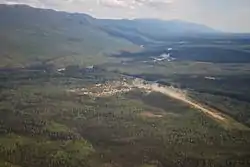Fort Ware
Fort Ware, is now the former name of the community of Kwadacha. Referred to by locals simply as Ware it is an aboriginal community in northern British Columbia, Canada, located in the Rocky Mountain Trench at the confluence of the Finlay, Kwadacha and Fox Rivers, in the Rocky Mountain Trench upstream from the end of the Finlay Reach (north arm) of Williston Lake. According to the Natural Resources Canada website,[1] the population of Fort Ware is 350. Fort Ware is in the federal electoral riding of Prince George-Peace River.
Fort Ware
Kwadacha | |
|---|---|
 View of Fort Ware from above looking Southeast | |
 Fort Ware Location of Fort Ware in British Columbia | |
| Coordinates: 57°25′15″N 125°37′20″W | |
| Country | |
| Province | |
| Population | |
| • Total | 350 |
| Area code(s) | 250, 778 |
Origins
Fort Ware's origins are as a trading post of the Hudson's Bay Company and as a still-older native community into which the company introduced its wares as well as commercial trapping, still a mainstay of life in the region. The aboriginal people of Fort Ware are part of the Kwadacha First Nation, who are Sekani people. The Kwadacha First Nation belongs to the Kaska Dena tribal council. Fort Ware was relocated from its original location due to the flooding of the lower Finlay Valley by Lake Williston in the late 1960s. Fort Ware was named after William Ware, from Manchester, England. He had a son named Joseph Ware who also worked for Hudson's Bay. William portaged across Canada to set up Telegraph Creek Trading Post. Along his travels he met and hunted with Louis Riel.
Finlay Forks
Some inhabitants of Fort Ware are relocatees and formerly lived at locations such as Finlay Forks, which had been located at the confluence of the Finlay and Parsnip Rivers; their combined flow was the beginning of the Peace River, which itself is now the Peace Arm of Lake Williston. Finlay Forks was another native community that was flooded out during the creation of Lake Williston, which is British Columbia's largest lake and one of the world's largest man-made lakes, and was formed by the Bennett Dam on the Peace River (completed 1967).
Infrastructure
No provincial highways reach the community, but a logging road extends north from the Prince George region and a bridge has been completed across the river that lies on the south side of the village. Fort Ware is 60km by logging road north of the Tsay Keh Dene village, whose people are closely related. The mountains which flank the western side of the Trench northwest from Fort Ware are the Omineca Mountains, vast subgroup of the Stikine Ranges. The nearby Muskwa-Kechika Management Area and Kwadacha Wilderness Provincial Park comprise a vast and rugged alpine region spanning the northern Rockies to the north and east of Fort Ware, which are for the most part even more inaccessible than Fort Ware, as are the Omineca Ranges.
Additionally there are a series of horse trails following the rocky mountain trench north, ending at the Alaska highway. These trails are not accessible by vehicle and thus is said to take around two weeks to traverse.
Telephone service was installed in the community by Northwestel in early 1986, connected by satellite to the long-distance network. Dial-up internet was provisioned circa 2005. There is no cellular service. Most air service and call traffic is exchanged southward to Mackenzie and Prince George.
External links
See also
- Fort Ware Airport (CAJ9)
- Fort Ware Water Aerodrome (CAW6)